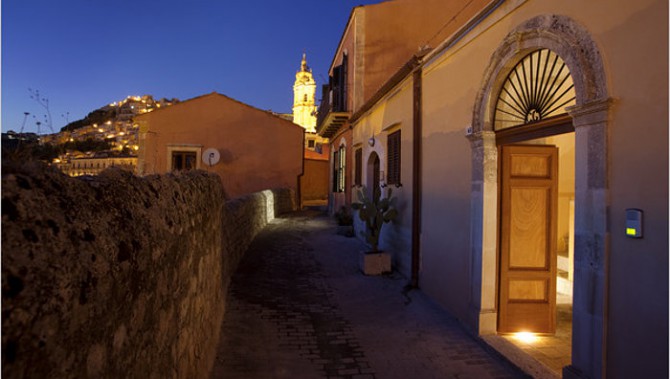In Sicily, Renovating a Cave
( The New York Times – 2009 – by Liza Foreman )
The New York architects William Brockschmidt and Richard Dragisic found their second home, Casa Grotta, in the southern Sicilian town of Modica.
Amid the fabled 100 churches that line the sun-cracked streets of this Sicilian city, the New York architects William Brockschmidt and Richard Dragisic found a second home.
By modern standards the property is no ordinary dwelling. It includes a centuries-old cave in the area’s volcanic rock that once was a place of worship and may have even been used as a tomb. The couple does not know exactly when the cave first became a living area but “the caves of Modica have been inhabited as troglodyte dwellings since the time of the Sikels,” Mr. Brockschmidt said, referring to some of the earliest inhabitants who gave the island its name.
Over the last few centuries, construction around the cave has created a two-story stucco property that Mr. Brockschmidt and Mr. Dragisic modernized into a two-bedroom two-bath home covering 3,000 square feet. (Think part Flintstones and part palazzo fit for a Sicilian prince.)
The men had been looking for a second home in Italy for some time. In 2006, they came across the property in Modica, a city of about 55,000 in southern Sicily.
The house is called the Casa Grotta. And when they found it, “the interiors were dark, smoky and in no way inhabitable, with dirt floors and no real light,” said Mr. Brockschmidt, 45, who is a principal at Brockschmidt & Coleman Decoration and Design in Manhattan. Mr. Dragisic, 50, is a senior architectural designer and partner at Fairfax & Sammons Architects, which has offices in Manhattan.
“We saw the house had potential because it had a sunny terrace, a room that could be opened as a loggia onto the walled courtyard, and an atmospheric, rustic cave,” Mr. Brockschmidt explained.
The home had not been occupied for about 60 years and was filled with debris, which had to be hauled away before any work could be started. The renovation of the 60,000-euro ($75,300) purchase presented a different challenge than their main home, a loft in a 20th-century warehouse in Manhattan. Here, they had to replace the staircase between the ground level and floor upstairs before it collapsed.
The cave, loggia and courtyard are on the ground level while the second floor houses the living room, master bedroom and an outdoor terrace decorated in yellow terra cotta tiles that they found in the nearby town of Gela. They painted the house a faded yellow to match.
They replaced the stairwell using stone from a nearby architectural salvage yard, where they also found some distinctive brown tiles made of the petroleum-infused limestone that is native to this area. They used it for the floors throughout the upper level of the house, where the rooms have 12-foot ceilings and restored French windows that offer views of the neighboring homes.
This past summer workmen created a kitchen, dining room, guest bedroom and half bath in the cave, which has its own unusual features like a bas-relief of a Madonna carved into the stone. There also is a 24-inch opening in one wall that, Mr. Brockschmidt said, probably was the tomb doorway and that they now use as a decorative feature.
During renovations, two cisterns were found in a subterranean part of the cave, possibly left by Greeks who colonized southern Italy and parts of Sicily 2,500 years ago. “We had fantasized about a cistern spa but the access was too tiny,” Mr. Brockschmidt said.
He said they are in no hurry to finish the house. And after a dozen visits, three years of labor and more than 150,000 euros ($213,000) in renovation costs, the couple finally was able to stay in the house in September to celebrate Mr. Dragisic’s 50th birthday.
“The fact that this may have been a tomb makes it creepy but all the more interesting,” Mr. Brockschmidt said.
